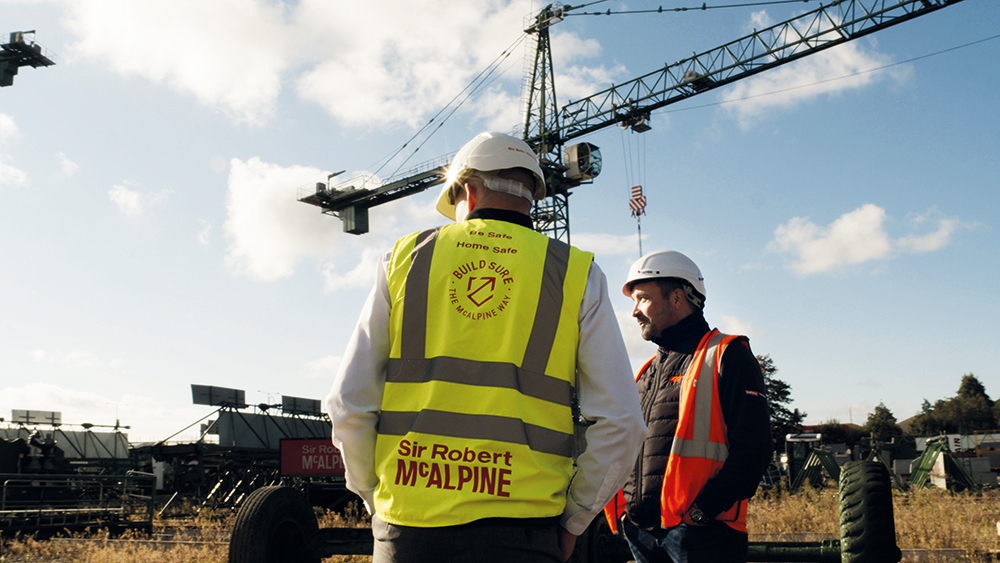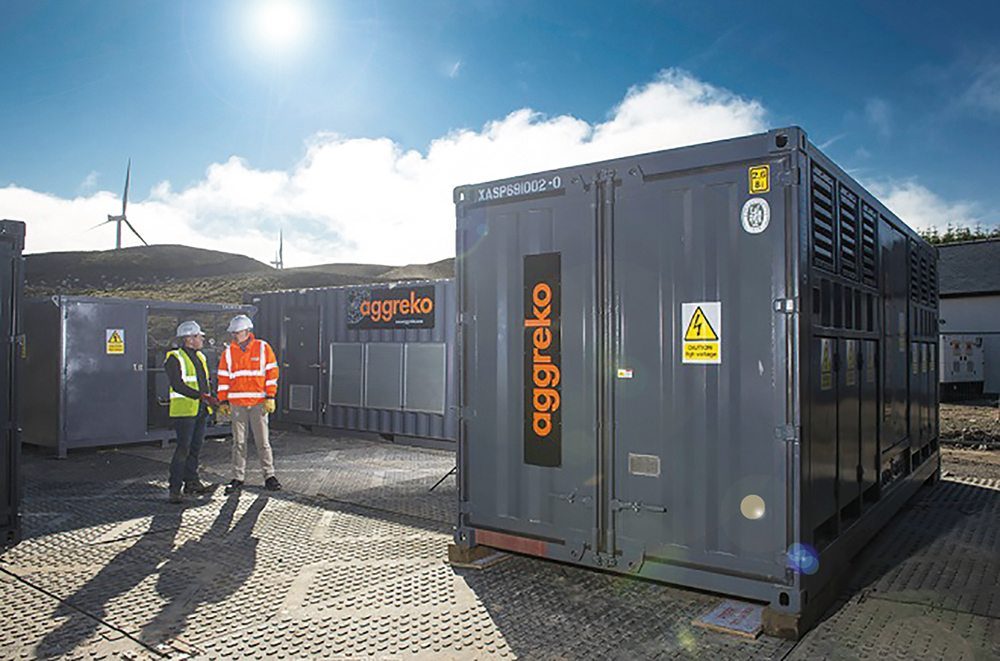
This CPD, in association with Aggreko, examines how construction companies can deliver cleaner power to sites as they attempt to reach their net zero carbon targets.
Noise around net zero is getting louder. Thousands of businesses across the UK have pledged to eliminate their carbon footprint by 2050, or earlier, and construction is no different.

Most major organisations have some plan in place, though often more ambitious when compared to other sectors, reflecting the need to tackle the high level of emissions generated across the built environment. According to the National Engineering Policy Centre, UK construction now needs to decarbonise more urgently so it can keep pace with national targets of 68% by 2030 and 78% by 2035.
The path to this goal, however, still remains unclear for many businesses. Not least those that have to manage investor expectations against the kind of bold, sweeping changes that net zero demands.But far from having to wait for newer, emerging solutions, experts believe that existing technologies and practices are more than capable of delivering progress today. It’s just a matter of testing them.
The power challenge
Generators are perhaps the best place to begin decarbonising construction in line with net zero targets. They typically run off diesel yet there are now alternatives available that can limit fossil fuel use to all but the most demanding or mission-critical phases of a build.
This is especially important given government plans to restrict use of red diesel for heavy plant from April 2022. Data also shows that generators are often oversized for their chosen application, leading to inefficiencies that could otherwise be easily avoided.
Construction managers will be well aware of the difficulties when specifying power for a project. The situation on the ground may change unexpectedly and there’s always the threat of dramatic or unseasonal weather. Demand can also change with short notice, leaving organisations stuck without sufficient power.
The natural response here is to overestimate how much power will be needed, opting for a larger generator or temporary substation that will be more than capable of handling whatever is thrown at it. But this brings its own set of problems.

Firstly, more power generation capacity means using more diesel and therefore a bigger carbon footprint. Secondly, organisations that habitually oversize their generators will be consuming fuel very inefficiently. Once running equipment drops down to around 10% capacity, for example, it’s essentially wasting up to 60% of the diesel per kWh of energy being used. Besides being needlessly wasteful, adopting this practice across a typical construction project could easily send budgets into the red without providing any real benefits in return.
To run efficiently, a generator should work between 40%-80% of its total capacity. Running a high-capacity generator beyond these limits can lead to ‘wet stacking’, where horsepower suddenly drops and performance becomes erratic. In the worst cases, this can lead to equipment failure and another unit will need ordering to complete a job.
“Once running equipment drops down to around 10% capacity, for example, it’s essentially wasting up to 60% of the diesel per kWh of energy being used.”
Oversizing is commonplace but it can be avoided with the right knowledge. Organisations are now beginning to recognise the importance of testing, especially when introducing greener upgrades, such as hybrid generators and those running on biofuels like HVO. Planning of this kind can not only save money but also lower fuel consumption and an organisation’s emissions penalty – critical in a time where wholesale carbon reductions are now necessary across the entire industry.
Coordinating suppliers
It’s this idea that provided the rationale for a series of field trials between Aggreko and Sir Robert McAlpine (SRM) in 2021. The project looked to understand which of Aggreko’s generator packages would be most efficient for powering two different sized cranes on site, in turn giving both organisations the practical knowledge needed to make more sustainable decisions at other builds across the country.
SRM has joined the Science Based Targets initiative (SBTi), which requires businesses to actively search for methods to reduce their emissions. Part of this involves looking for energy-intensive processes that can be made more efficient, known as ‘hot spotting’, as well as identifying areas where fossil fuels can be swapped out completely for greener sources. These efforts are then submitted to the SBTi for assessment and verification. Aggreko’s power expertise and focus on sustainability made it a natural partner for this project.

The work was also carried out in the knowledge that net zero cannot be achieved in isolation, and even the most ambitious businesses will struggle to make lasting changes without cooperating with partners and other supporting organisations across the supply chain.
Trialling greener upgrades
The field trials were based on lifting applications using two different types of tower crane at full working capacity (hoisting and slewing 12.5 tonne weights). Both cranes are used in SRM’s yard and in the field. All tests were run on HVO fuel.
Scenario 1: standard crane
The first scenario involved a 200kVA generator, which already represented a downsizing from SRM’s request for a 250kVA. This smaller model ran comfortably.
Aggreko also applied a 100kVA model, which was also able to handle the job without any loss in performance, then introduced batteries to the generator’s control mechanism to see if fuel consumption could be avoided entirely. This also met the crane’s demands, with SRM able to load materials onto three lorries for over two hours without the generator firing up.
Data showed a maximum power of 94kW and an average fuel consumption of 37 litres per hour at this load.
- The 200kVA had a max output of 160kW, so only ran at 58% of its total capacity, leaving 42% extra power unused.
- Maximum readings never exceed 100kW, proving a smaller set up is better matched than the 250kVA generator originally specified.
Scenario 2: luffing crane
The second scenario used a bigger crane, at first running on a 320kVA generator to establish baseline data. Aggreko then introduced a 200kVA model, which could easily handle the crane’s demands. A battery hybrid was again introduced afterwards, and able to support the job, though greater care was needed from operators to avoid spikes in demand.
Depot engineers operated the crane at full working capacity, lifting a 12.5 tonne weight while luffing and hoisting, so accurate loading could be determined.
- Data showed a maximum power of 121kW and average fuel consumption of 18 litres per hour at this load.
- The 320kVA model had a maximum output of 256kW, meaning 53% extra power was unused.
For more information about this project, please visit: https://tinyurl.com/4m7x3bwt.
Results
The fuel and emissions savings listed are projections based on an average project window of 26 weeks
Emissions calculations are estimations and based on the assumption:
- 1,000 litres of diesel (based on EN 16258 standard, ISO conditions and IPCC 2006) would result in 3.26 tonnes of CO2e
- 1,000 litres of HVO (based on Neste 8g/MJ) would result in 275kg of CO2e
- Diesel burns at roughly the same rate as HVO.
Scenario 1
200kVA (diesel) to 100kVA battery hybrid (HVO)
Fuel savings: from 52,416 litres to 27,757 litres = ~ 47% decrease
Emissions savings: from 170,876kg of CO2e to 7,633kg of CO2e = ~ 95% decrease
200kVA to 100kVA battery hybrid (both running on HVO)
Fuel savings: from 52,416 litres to 27,757 litres = ~ 47% decrease
Emissions savings: from 14,414kg of CO2e to 7,633kg of CO2e = ~ 47% decrease
Scenario 2
320kVA (diesel) to 200kVA (HVO)
Fuel savings: from 96,096 litres to 52,926 = ~ 45% decrease
Emissions savings: from 313,272kg of CO2e to 14,554kg of CO2e = ~ 96% decrease
320kVA to 200kVA hybrid (both running on HVO)
Fuel savings: from 96,096 litres to 52,926 = ~ 45% decrease
Emissions savings: from 26,426kg of CO2e to 14,554kg of CO2e = ~ 45% decrease
What do these results mean for construction managers?
There are practical moves that can be made to reduce emissions – here is our checklist.
The results show construction managers can make practical swaps that deliver a significant drop in emissions, while also reducing the amount of fuel used and money spent on plant. Even tower cranes are capable of running on hybrids and HVO fuel, clearing the way for a wider phase-out of diesel on construction sites.
Arguably the most telling finding can be seen in the continued oversizing of generators. The plant that SRM originally used was still too large for powering the cranes, and a large percentage of the power was left unused. Aggreko has long been aware of this idling issue, and it serves to show how even minor changes can bring about profound improvements for the sustainability of UK construction.
Checklist for managers
- Identify suppliers that can provide access to greener upgrades and more sustainable power solutions.
- Determine where you can make immediate changes to save on fuel and emissions – can hybrid generators or HVO fuel be used instead of diesel?
- Question if the generators you currently use are too big for a job – the results of the project in this CPD suggest all but the most demanding applications now require diesel generation.
- Carry out thorough testing to establish what kinds of generators are best matched for each job on site – this will ensure they are always correctly sized and running optimally.
This article has been created by Construction Management in partnership with Aggreko




